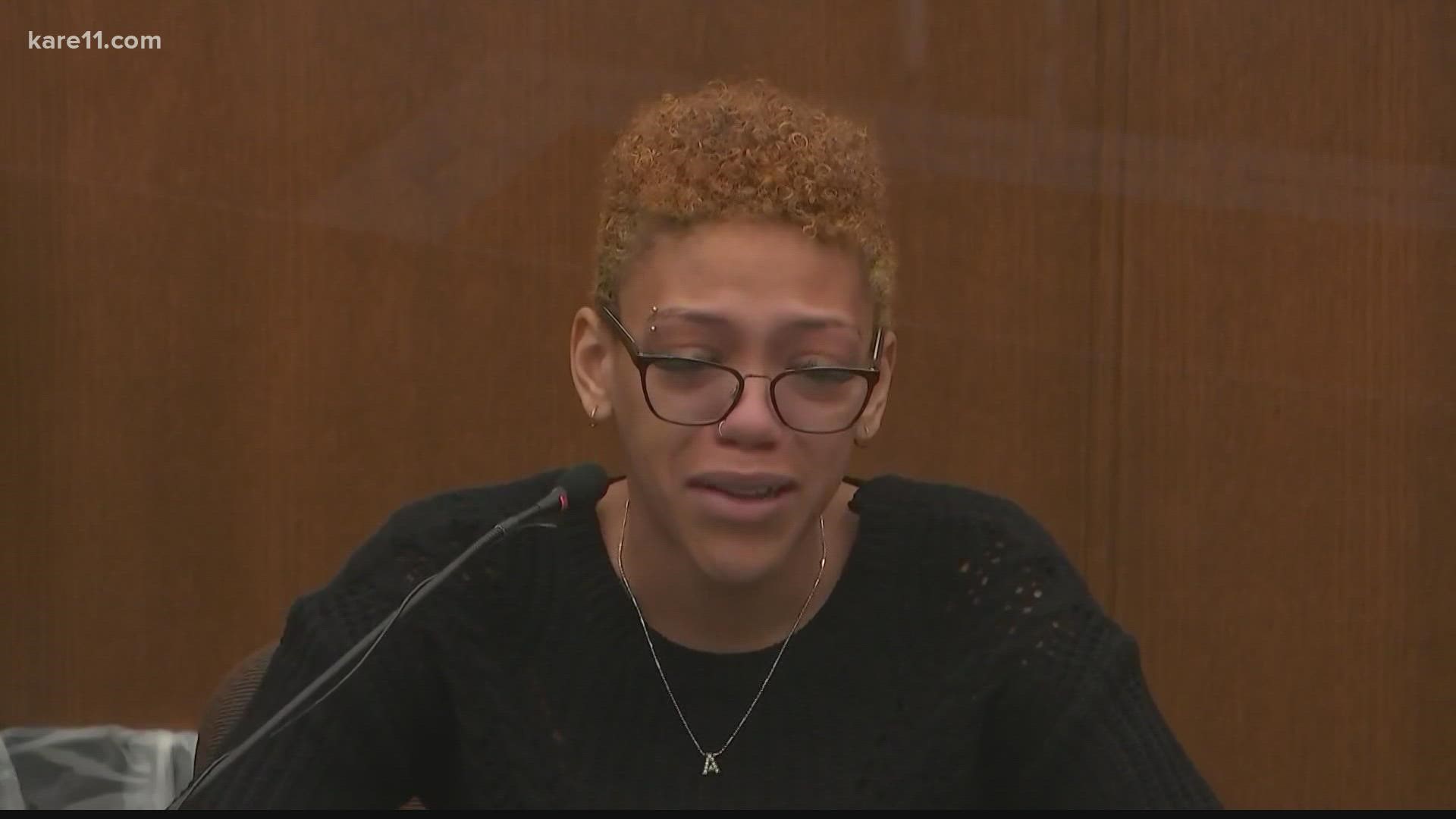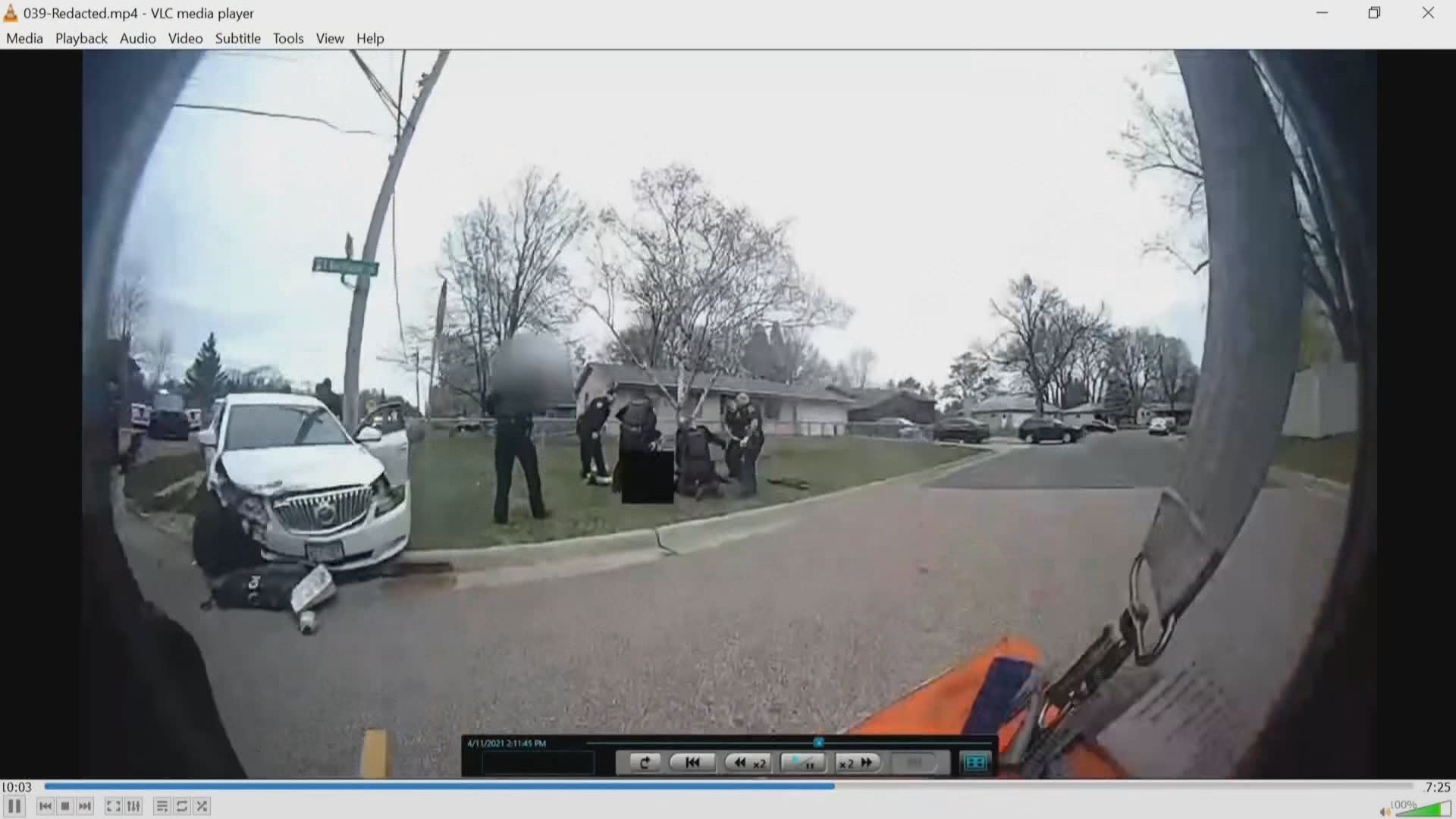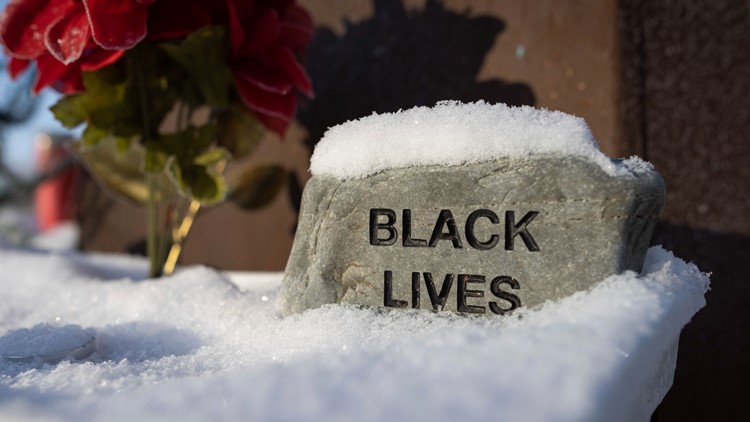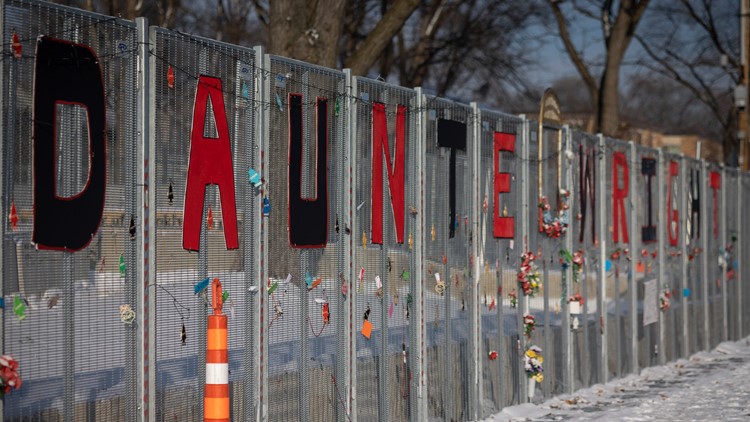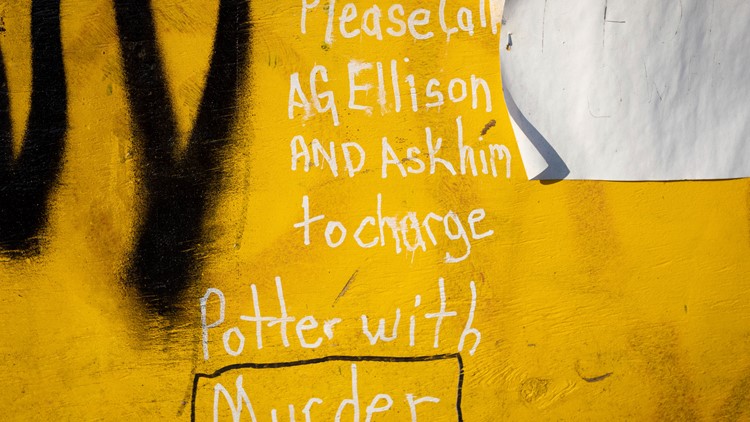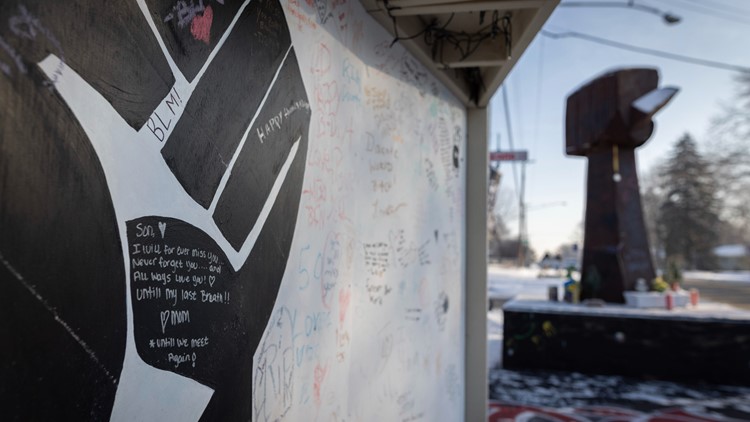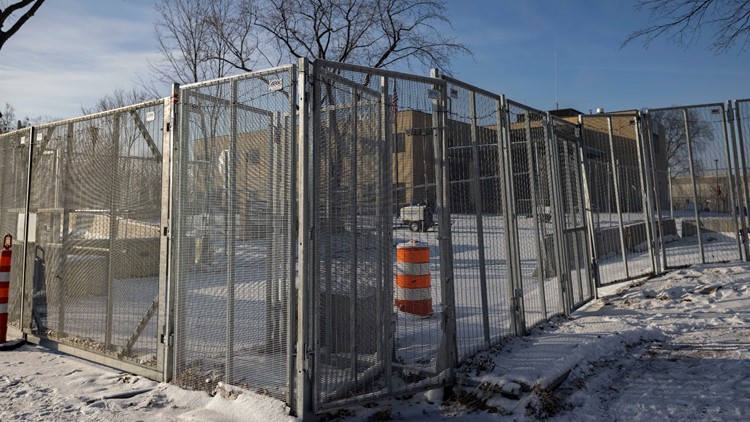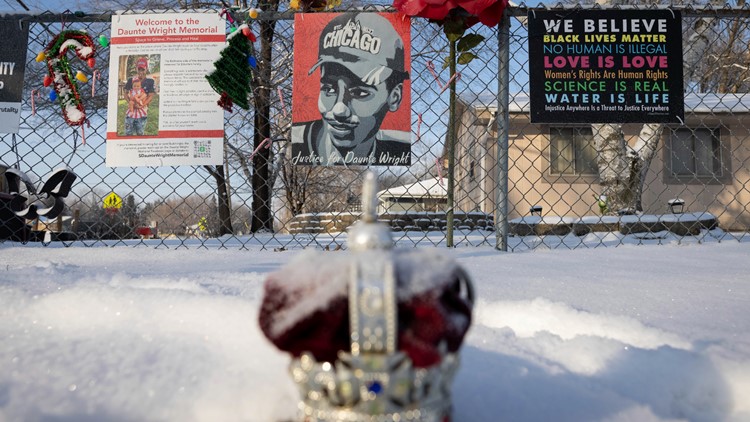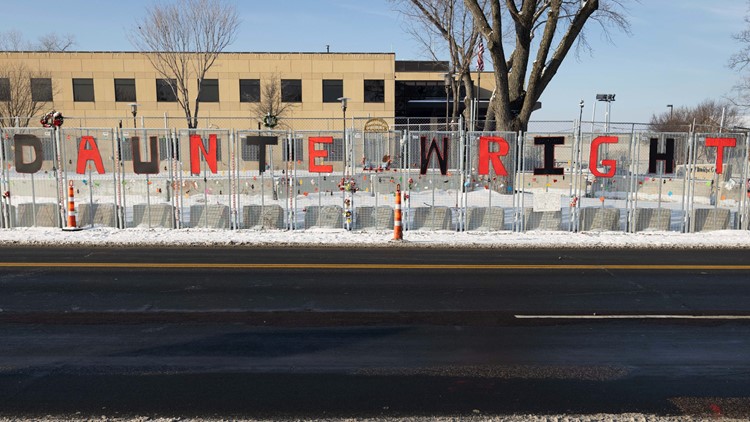MINNEAPOLIS —
- North Memorial Ambulance supervisor Mike Morelock and paramedic Dustin Johnson detail Daunte Wright's condition as they attempted life-saving measures
- Three police officers, two from Brooklyn Center and one from Champlin, describe hectic scene on arrival
- Wright's girlfriend Alayna Albrecht-Payton describes fatal police encounter
- State called Daunte Wright's mother Katie Bryant and Brooklyn Center Police Officer Anthony Luckey to testify Wednesday
- Video of Kim Potter's reaction to shooting Daunte Wright played in court
Thursday, Dec. 9 - Day 2
The girlfriend of Daunte Wright was the first witness called on Day 2 of the trial of Kim Potter, the former Brooklyn Center police officer charged with manslaughter in Wright's fatal shooting.
Prosecutors first questioned a tearful Alayna Albrecht-Payton, who told jurors about her relationship with Daunte Wright and described their final hours together, including the traffic stop that led to his death.
The state then proceeded to call a series of witnesses who detailed the crash scene that unfolded after Daunte Wright was shot, with his vehicle rolling down 63rd Avenue with his foot on the gas pedal. The testimony appeared to be intended to illustrate the ripple effect of lives impacted following Potter's firing of her weapon.
Eighty-four-year-old Patricia Lundgren was called to the stand, explaining she was driving the car that was struck by Daunte Wright's vehicle as it rolled away from the shooting scene. She told the court she was in the vehicle with her 86-year-old husband, and was surprised when no one came to help them in the crash’s immediate aftermath.
She said after paramedics did finally tend to them, they were brought to the police station where they waited, but were never questioned. She said her husband is now in hospice care with “lots of problems…lots worse since the accident.”
Lundgren’s daughter took the stand following her mother, and confirmed that the crash had devastating impact on her father.
The next witness, Brooklyn Center police officer Alan Salvosa, told the courtroom that he heard about a traffic stop involving a warrant over his radio and decided to respond as backup. Prosecutors played Salvosa’s body camera and squad car footage, showing Wright’s car crashing into Lundgren’s vehicle and the moment Salvosa got out of his squad car and confronted Albrecht-Payton with his gun drawn. He continued to point his weapon at Wright’s vehicle as ambulances arrived.
Champlin police officer Daniel Irish described a similar scene as he arrived to back up Salvosa, saying he joined other officers trying to safely approach Wright’s vehicle, uncertain if anyone was armed inside. He told the court as soon as he determined Wright was unconscious, he and other officers pulled him out and laid him on the ground. He said he then checked Wright for injuries, locating his gunshot wound, and performed life-saving measures. He said when paramedics arrived, they told him to stop attempting to resuscitate Wright, assuming that direction meant he was dead. He agreed with the defense that he did everything he could to save Wright’s life.
Officer Jeffery Sommers’ story seemed to align with that of both Salvosa and Irish. After arriving on scene and determining that Wright was not a threat, he assisted with CPR until paramedics arrived.
When paramedics had taken over, he said he was tasked with scene security for a number of hours following the shooting.
Prosecutors ended their line of questioning for the day after calling two responding paramedics to the stand. The first, Mike Morelock, was an ambulance operations supervisor with North Memorial Ambulance. He said as he was made aware of the incident, and because he heard there might have been multiple victims, he brought someone from the garage with him, as well as tasked a team of paramedics to follow behind in an ambulance.
When Morelock arrived, he said he checked for Wright’s pulse, and when he could detect one, instructed officers to keep performing CPR. When the team of paramedics arrived, they continued to work on Wright before calling his death.
One of the paramedics who responded, Dustin Johnson, appeared as the state’s last witness of the day. He said his further attempts to revive Wright, as well as attempts by his partner, were unsuccessful. The group of medics decided to pronounce Wright’s death and tend to other potential victims.
They were directed to a squad car containing Albrecht-Payton and based on her apparent physical trauma, transported her to the hospital, where they handed her care over to hospital staff.
As the second day of witness testimony came to a close, defense attorney Paul Engh took to the podium to ask Judge Chu for a mistrial. He said the defense was “concerned with the presentation of the state’s case,” claiming an “unending” amount of time was spent on prejudicial evidence that he said lacked relevance to “what really matters in the case.”
Prosecutor Matthew Frank said the evidence presented by the state on Thursday goes toward the state’s Blakely evidence, which they need to prove aggravating factors to get a lengthier sentence than the guidelines call for if Potter is found guilty. He told Chu he didn’t believe the presentation of any of the state’s evidence rose to the level of a mistrial.
Judge Chu denied the defense’s motion.
Court is scheduled to resume Friday at 10 a.m.
LIVE UPDATES
4:30 p.m.
As the second day of witness testimony came to a close, defense attorney Paul Engh took to the podium to ask Judge Chu for a mistrial. He said the defense was “concerned with the presentation of the state’s case,” claiming an “unending” amount of time was spent on prejudicial evidence that he said lacked relevance to “what really matters in the case.”
Prosecutor Matthew Frank said the evidence presented by the state on Thursday goes toward the state’s Blakely evidence, which they need to prove aggravating factors to get a lengthier sentence than the guidelines call for if Potter is found guilty. He said the fact that her actions presented a “violation of trust and authority,” and that her “conduct presented danger to more individuals” than only those in the immediate area. He told Chu he didn’t believe the presentation of any of the state’s evidence rose to the level of a mistrial.
Judge Chu denied the defense’s motion.
Court is scheduled to resume Friday at 10 a.m.
4:05 p.m.
One of the paramedics who responded to the scene on April 11, Dustin Johnson, was the state’s next witness. Johnson told the court he had also been a combat medic in the armed forces from 2007-2019.
Johnson told Eldridge he and his partner responded to the call from dispatch, hearing it was a shooting, possibly with multiple victims. He said after the scene was determined to be safe, Morelock directed them to enter and tend to Wright. Johnson said he observed trauma to Wright’s chest and tracheal deviation. He told the court he checked for Wright’s pulse several times, but was unable to detect one.
Johnson said after further attempts to revive Wright, it was decided that with the apparent amount of trauma and lack of pulse, medics would suspend efforts on Wright and tend to other patients. That’s when he was directed to a squad car to help a woman with blood coming from her mouth and ear.
Without having a lot of information at the time, Johnson said the concern was that the woman had trauma to her head, and walked her over to the ambulance and transported her to North Memorial Hospital in Robbinsdale. She was brought to a stabilization room and handed off to hospital staff for care.
Johnson left the stand after the defense declined to cross examine him.
3:30 p.m.
Mike Morelock, ambulance operations supervisor with North Memorial Ambulance’s metro division, was next to take the stand. He told Eldridge he has worked as a supervisor for the last three-and-a-half years, and was previously a street and flight paramedic.
Morelock said he responded to the call on April 11, 2021, that at first was received as a single shooting and was later told that three people had been shot. Morelock said that because he believed three people had been shot, he responded by bringing another person with him from the garage, while an ambulance followed behind them.
Morelock said that as he arrived, he observed a group of officers around a body, later identified as Wright, while some of the officers were performing CPR. He said he felt for a pulse on each side of Wright’s neck but was unable to detect one. He said Wright also did not appear to be breathing and the color of his skin indicated that blood did not appear to be flowing through his body.
After observing Wright’s injuries, Morelock directed police to continue CPR until paramedics arrived. He said after medics checked for a pulse and attempted more life-saving measures, they called Wright’s death, stopped working to resuscitate him, and Morelock directed paramedics to tend to other individuals.
The defense chose not to cross examine him.
3 p.m.
The next witness called to the stand was Brooklyn Center police officer Jeffery Allen Sommers. Sommers has been with the department since 2010 and served as a United States Marine for 29 years. He told prosecutor Eldridge that he has medical training and is a certified first responder.
Sommers told the courtroom that prior to April, he was assigned the same shift as Potter for at least the last five years.
Officer Sommers said he was working in the department’s report writing room when he initially heard the traffic stop call made by officer Luckey, who was asking dispatch to send a second car. Sommers said it wasn’t until he heard the shots fired call that he immediately responded to the scene. He said on his way, he heard that officer Salvosa had a person at gunpoint and didn’t know what to expect when he arrived. The prosecution then showed footage from Sommers’ body camera, where he can be seen outside Wright’s vehicle with his gun drawn, along with another officer. He told Eldridge the officers “had to assume” there was a firearm in the vehicle, and that’s why they took those precautions.
Sommers said after Wright’s body was removed from the car, he participated in life-saving measures. Sommers went on to say that when paramedics arrived, they assessed whether Wright had a pulse. They determined he did not and at that moment pronounced him dead. He said he was then tasked with staying with Wright’s mother and father who had arrived on scene, and ultimately provided scene security for a number of hours.
The defense did not cross examine Sommers and he was allowed to step down from the stand.
2:40 p.m.
Court resumed from a short break just before 3 p.m. Judge Chu explained that she met with the attorneys in her chambers to discuss the permittance of a rash photos as exhibits. She said a number of them are cumulative so she will restrict them from being shown to the jury.
Prosecutor Larson resumed questioning of Irish, asking him to describe the scene as he arrived. He said he attempted life-saving measures with other officers. He told Larson he left as paramedics arrived.
During cross-examination, Engh asked Irish to further explain the scene as he arrived. He told Engh he arrived after officers had already drawn their guns and a woman had been taken out of the vehicle. He said a bunker was then used – a protective shield used to rebuff bullets – and agreed that the scene appeared to be dangerous. Irish then said he performed CPR on Wright, and followed the guidance of the AED machine present to continue with CPR and not administer a shock. Irish agreed he did everything he could to save Wright’s life.
1:30 p.m.
Officer Daniel Irish of the Champlin Police Department took the stand following lunch break to detail his role on the scene of the crash following the shooting of Daunte Wright by then-Brooklyn Center officer Kim Potter.
Irish told prosecutor Josh Larson he was on patrol in Champlin when he heard a shots fired call on the Hennepin County east main radio channel. He described turning on his lights and siren while heading for the shooting scene, and then heard a radio call from Brooklyn Center officer Alan Salvosa, saying he was holding one at gunpoint.
Officer Irish is a decorated medical first responder with seven accommodations for saving lives in the field. He told the jury after arriving on scene he joined multiple other officers in hatching a plan to safely approach Wright's damaged vehicle, uncertain if anyone inside was armed. After officers reached the car Irish moved to the driver's side door and found Wright unresponsive, his head tilted to the right. He described helping another officer pull Wright out of the car and lay him on the boulevard grass.
Irish told the court he assessed Wright for injuries and located a gunshot wound to his chest, with the bullet moving from the left to right side. He checked for a pulse, applied a chest seal on the exit wound and called for a defibrillator. The officer testified that when the AED electrodes were applied to Daunte Wright the machine did not detect a measurable heart rhythm, said a shock was not advised and to start manual CPR. Repeated checks did not detect a pulse and arriving paramedics eventually told officers to stop lifesaving measures, which Irish took to mean that Wright was deceased.
11:20 a.m.
After taking a 20 minute morning break prosecutors began calling witnesses to document the crash scene involving Wright's car, including a neighbor and a Brooklyn Center police officer.
Officer Alan Salvosa described how he was at lunch when he heard over the radio a traffic stop on 63rd Ave. involving a warrant, and decided to provide backup. Hennepin County Assistant District Attorney Josh Larson played several videos from Salvosa's squad car and body cameras that captured the white Buick driven by Daunte Wright crossing the centerline of the busy street and crashing into the vehicle in front of his squad.
The videos show Salvosa jumping out of his squad with his gun drawn, shouting "put your hands up" repeatedly. A faint voice, later identified as Alayna Albrecht-Payton, cries "I can't!" The officer then orders three ambulances to treat those involved, all while keeping his gun trained on Wright's vehicle.
WARNING: The video below from today's court proceedings contains graphic content. Viewer discretion is advised.
Salvosa's body camera captures him grabbing a medical bag from the back of his squad, and running it to a group of officers who had pulled Wright from the smashed-up vehicle and laid him on the ground. In the next few minutes the officer has several conversations that reflect chaos, confusion and a lack of clarity as to what actually occurred before the crash.
10:00 a.m.
The second witness called Thursday was 84-year-old Patricia Lundgren, who was driving the car that was struck by Daunte Wright's vehicle as it rolled away from the shooting scene with his foot on the accelerator.
Assistant Attorney General Matthew Frank asked Lundgren about the incident, and she described how Wright's car crossed the center line and cut right across her lanes before the vehicles collided. Lundgren said the airbags went off, her 86-year-old husband was moaning, and recalls being surprised no one came to help them.
Lundgren told the courtroom that paramedics checked her and her husband out, and then they were taken to the police station where they waited for three hours but were never questioned about the crash.
Frank asked Lundgren whether her husband had significant health problems before the crash, and she said no. When the prosecutor asked if things had changed since that day, Lundgren said yes.
"He (Ken) is on hospice care now... yeah, he has lots of problems... lots worse since the accident."
Defense attorney Earl Gray followed up by asking about a statement Lundgren eventually made to police. "You also stated if it hadn't been a Subaru.. you and your husband would have died," Gray told the court. He also reminded Lundgren that she asked police if the other driver (Wright) had insurance.
Lundgren's daughter, 62-year-old Denise Lundgren-Wells, was called to the stand and also told jurors the crash her parents were in had a devastating impact on her father Ken. She says his balance is suspect, a bad fall landed him in the hospital and he is now obsessed with death.
9:15 a.m.
Assistant Minnesota Attorney General Erin Eldridge began the questioning of 20-year-old Alayna Albrecht-Payton, who told the court she and Wright met on Facebook and were just beginning their relationship. She was riding with Wright the afternoon of April 11, when the vehicle he was driving was pulled over by Brooklyn Center police.
"He was really scared, like I never seen him like that before," Albrecht-Payton recalled. "He's just really happy, he's positive, he cant really be like sad or depressed or angry... he was just like such so nervous and flustered, I could tell he was scared."
Albrecht-Payton recalled police repeatedly asking Wright to leave the vehicle, and she told jurors eventually he did. She told the jury she did not remember scuffling, but suddenly there was a gunshot.
"I just remember hearing the boom, the bang of the gun," Albrecht-Payton said through tears. "I was trying to push on his chest, call his name... he was just gasping, taking big breaths of air."
Albrecht described talking to Wright's mother on a video call, recalling that she showed Katie Bryant her wounded son, and then apologized for doing so.
The state then played a bodycam video of Albrecht-Payton being led away from Wright's vehicle, and officers handcuffing her as they didn't know what her role was in what had happened.
Eldridge showed the jury a picture of Wright's car, which collided with another vehicle as it rolled away from the scene. The windshield was shattered where Albrecht-Payton was sitting. She described suffering a fractured jaw, a concussion, and lacerations on both her lip and ear that needed to be stitched up.
On cross-examination defense attorney Earl Gray asked Albrecht-Payton a number of questions about the nature of her relationship: How long they had dated, how they met and how often Wright stayed at her home.
Gray asked Albrecht-Payton if Wright had smoked marijuana the morning of April 11, and she said yes, admitting to jurors that she did as well. She told Gray it had no affect on either of them.
When Gray asked about her past with police, Albrecht-Gray told jurors that her father had a criminal past. "Most times they were never good (encounters with police) when it was around my dad... just seeing negative encounters with the police," she said.
During the questioning of Wright's girlfriend Eldridge and Gray sparred repeatedly, trading objections and requiring Judge Regina Chu to intervene. A particular point that was debated was whether Wright's car was running throughout the encounter with police. Albrecht-Payton told both the defense and prosecution she did not know.
Wednesday, Dec. 8
On Wednesday, Eldridge issued the prosecution's hour-long opening statement. Eldridge showed the jury a photo of Potter in her uniform wearing her utility belt, demonstrating where her firearm and Taser are normally carried. Eldridge told the court about Potter's extensive training on “weapon confusion” and other cases in which an officer pulled a Taser instead of a gun.
“We trust them to know wrong from right, and left from right,” Eldridge said.
Attorney Paul Engh followed by outlining the case that will be laid out by the defense. Engh told jurors that in the moments leading up to Wright’s death, Potter believed his actions could have harmed a fellow officer, and while she did pull the trigger on her firearm Potter “made a mistake” and meant to use her Taser.
“She made a mistake. This was an accident. She’s a human being. But she had to do what she had to do to prevent a death to a fellow officer, too,” Engh insisted.
Katie Bryant, Daunte Wright’s mother, was the prosecution's first witness. On the stand she talked about her family and other children, then pivoted to describing Daunte: "He had a smile that would light up a room.”
Bryant's emotional testimony in the courtroom described the day of Wright's death, and the phone conversation she had with him during the first part of his detainment and arrest. She testified the call was disconnected before her son was shot.
Bryant testified that when she arrived at the scene, she saw Wright’s crashed car and his body lying under a white sheet.
Earl Gray, one of Potter’s defense attorneys, led the cross examination of Bryant. She told Gray she was aware that Daunte did not have a driver’s license but was unaware of his marijuana use. Bryant also acknowledged that she didn’t know there was a warrant out for his arrest at the time of the shooting.
Brooklyn Center police officer Anthony Luckey, the officer training with Potter on the day of the shooting, took the stand following Bryant's testimony. He told prosecutor Matthew Frank that he was driving the squad car that pulled Wright over for having an air freshener hanging from his rearview mirror. Luckey said he also observed Wright’s expired tabs on his car.
The told Frank he smelled marijuana when Wright rolled down his window and confirmed Wright showed him outdated insurance with someone else’s name on it. Luckey described the attempted arrest of Wright, saying as he went to handcuff him, Wright “jerked his arm back,” and got back into his vehicle. The officer said that's when he heard Potter say, “I’m going to Tase you,” before hearing a firearm go off.
The prosecution showed body camera footage of the incident, where Potter can be seen screaming and crying in the aftermath of the shooting, saying she pulled the wrong gun and, “I’m going to prison.”
Engh cross-examined Luckey for the defense, asking him if he thought Wright had a gun. Luckey said he always assumes there’s a gun in every car he stops out of safety, but admitted that particular traffic stop was more dangerous than previously portrayed. He testified that if he were in Potter's position he would have fired his Taser as well.
Outside the courtroom Wednesday a group of 50 to 100 people gathered to show their support for the Wright family. Other family members of people previously killed by police were there, including the families of Breonna Taylor and Jacob Blake, and Courteney Ross, the fiancé of George Floyd.
Organizers said they wanted to give the family a sense of solidarity as they relive the events of April 11 during the trial.
Court is expected to resume Thursday morning at 9 a.m.

